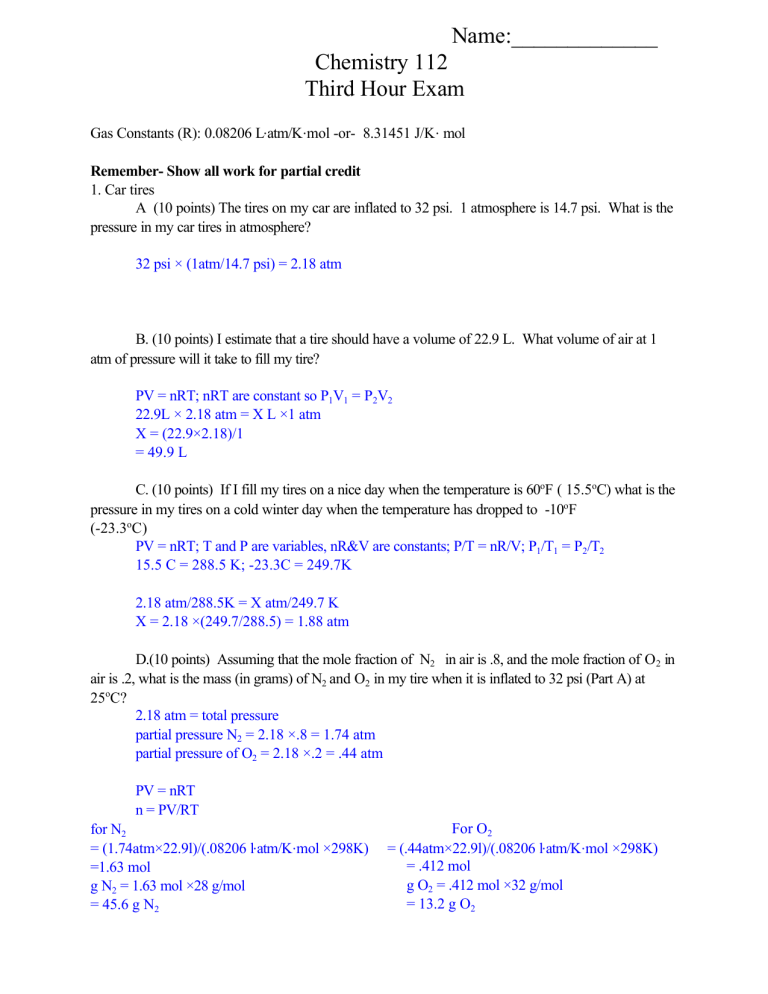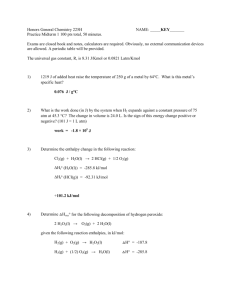Name:_____________ Chemistry 112 Third Hour Exam

Name:_____________
Chemistry 112
Third Hour Exam
Gas Constants (R): 0.08206 L @ atm/K @ mol -or- 8.31451 J/K @ mol
Remember- Show all work for partial credit
1. Car tires
A (10 points) The tires on my car are inflated to 32 psi. 1 atmosphere is 14.7 psi. What is the pressure in my car tires in atmosphere?
32 psi × (1atm/14.7 psi) = 2.18 atm
B. (10 points) I estimate that a tire should have a volume of 22.9 L. What volume of air at 1 atm of pressure will it take to fill my tire?
PV = nRT; nRT are constant so P
1
V
1
= P
2
V
2
22.9L × 2.18 atm = X L ×1 atm
X = (22.9×2.18)/1
= 49.9 L
C. (10 points) If I fill my tires on a nice day when the temperature is 60 o F ( 15.5
o C) what is the pressure in my tires on a cold winter day when the temperature has dropped to -10 o F
(-23.3
o
C)
PV = nRT; T and P are variables, nR&V are constants; P/T = nR/V; P
1
/T
1
= P
2
/T
2
15.5 C = 288.5 K; -23.3C = 249.7K
2.18 atm/288.5K = X atm/249.7 K
X = 2.18 ×(249.7/288.5) = 1.88 atm
D.(10 points) Assuming that the mole fraction of N
2
in air is .8, and the mole fraction of O
2
in air is .2, what is the mass (in grams) of N
2 and O
2
in my tire when it is inflated to 32 psi (Part A) at
25 o C?
2.18 atm = total pressure partial pressure N
2
= 2.18 ×.8 = 1.74 atm partial pressure of O
2
= 2.18 ×.2 = .44 atm
PV = nRT n = PV/RT for N
2
For O
2
= (1.74atm×22.9l)/(.08206 l @ atm/K @ mol ×298K) = (.44atm×22.9l)/(.08206 l @ atm/K @ mol ×298K)
=1.63 mol = .412 mol g N
2
= 1.63 mol ×28 g/mol
= 45.6 g N
2 g O
2
= .412 mol ×32 g/mol
= 13.2 g O
2
2. (10 points) In the lab you reacted 3.5 g of Cu with nitric acid to form NO
2
gas. The equation for the reaction is:
Cu(s) + 2NO
3
-
(aq)
+ 4H + (aq) 6 Cu 2+ (aq)+ 2NO
2
(g) + 2H
2
0(l)
2
What was the volume of NO
2
gas made by your reaction at STP?
3.5 g Cu ×(1 mole Cu/63.55g Cu)×(2 mole NO
2
/1 mole Cu) = .110 mol NO
2 at STP 1 mol gas occupies 22.42 l so
22.42 l/mol × .110 mol = 2.47 l
3.(6 points) The van der Waals equation for a non-ideal gas is:
P obs
= nRT
V
− nb n
V
2
The a and b terms are placed in this equation to correct for the non-ideality of a real gas. Give a physical explanation for these correction terms.
The a term corrects for gas molecules interacting with each other, while the b term corrects for the volume of the gas molecule itself
4. (7 points) I have a thermodynamic system where ) E = -240 kJ and q = 56 kJ, how many kJ of work is being done? Is this work being done by the system on the surroundings or vice-versa?
) E = q + w
-240 kJ = 56 kJ + X
X = -240 -56
= -296 kJ sign is negative so system is working on the surroundings
5. (7 points) What are the equations for internal energy and enthalpy and how are different?
) E = q + w
) H = ) E + ) (PV)
) H may be though of as ) E plus an additional pressure-volume term
) E = q
V
) H = q
P
5. (10 points) I have a piece of iron that I heat up to 240 o C. I am going to place that iron in 1 L of water that is at 25 o C. As the iron cools it will heat the water to 37 o C. What is the mass of the piece of iron? (Assume no heat is lost or gained form the surroundings. Specific heat capacity of iron is 0.45
J/C o @ g, for water it is 4.184 J/C o @ g)
Heat lost by iron = heat gained by water; final temperature of iron = final temp of water
Heat lost by iron = SHC ×g× ) T = (.45 J/ o C @ mol) × X ×(240-37) o C
Heat gained by water = (4.184 J/ o C @ mol) × X ×(37-25) o C
(.45 J/ o C @ mol) × X ×(240-37) o C = (4.184 J/ o C @ mol) × X ×(37-25) o C
.45(X)203 = .45(1000)12
X = [4.184(1000)12]/[.45(203)]
X = 549.6 g
3
6. (10 points) Given the following values, what is the ) H rxn
for the conversion of Cu(OH)
2
to CuO?
Substance ) H f
(kJ/mol)
-450 Cu(OH)
2
CuO -156
H
2
O -286
Cu(OH)
2
6 CuO + H
2
O
) H = 3 n p
) H
Fp
3 n r
) H
F(r)
= -156 -286 -(-450)
= + 8 kJ/mol
Does the sign of this result agree with what you observed in the lab, that you must heat Cu(OH)
2
to make CuO?
+ means you need to bring in heat from the surroundings. In lab we had to heat the reaction. Yes this agrees.
7. (10 points) Given the following data:
C
2
H
2
(g) + 5/2 O
2
(g) 6 2CO
2
(g) + H
2
O(l)
C(s) + O
2
(g) 6 CO
2
(g)
H
2
(g) + ½ O
2
(g) 6 H
2
O(l) calculate ) H for the reaction :
2C(s) + H
2
(g) 6 C
2
H
2
(g)
2CO
2
(g) + H
2
O(l) 6 C
2
H
2
(g) + 5/2 O
2
(g)
2×[C(s) + O
2
(g) 6 CO
2
(g)]
H
2
(g) + ½ O
2
(g) 6 H
2
O(l)
) H=-1300. kJ
) H=-395. kJ
) H=-286. kJ
)
)
)
H=+1300. kJ
H=-395. kJ ×2
H=-286. kJ
2CO
2
(g) + H
2
O(l)+2C(s) + 2 O
2
(g) + H
2
(g) + ½ O
) H=+1300. -2(395) -286
2
(g) 6 C
2
H
2
(g) + 5/2 O
2
(g) + 2 CO
2
(g) + H
2
O(l)
2C(s)+ H
2
(g) + ½ O
2
(g) 6 C
2
H
2
(g) ) H= + 224 kJ/mol









